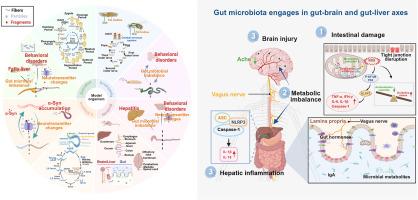微塑料和纳米塑料对肠道和内脏器官轴的物理化学性质和联合毒性作用
IF 15.4
1区 农林科学
Q1 FOOD SCIENCE & TECHNOLOGY
引用次数: 0
摘要
微塑料和纳米塑料是新兴的食源性污染物,对人类健康构成重大威胁,特别是通过它们与肠-脑轴的相互作用而未得到充分研究。在这里,我们深入探索了微塑料和纳米塑料毒性作用的机制途径,重点关注它们对肠道微生物群稳态、肠道屏障完整性、氧化应激、炎症和免疫调节的影响。通过对秀丽隐杆线虫、达尼奥河鼠、果蝇和啮齿动物等多种模式生物的研究,我们综合了目前关于塑料颗粒破坏肠道功能和诱导全身毒性的多种方式的知识,为肠道毒性和肠道外器官损伤的影响和潜在机制提供了有价值的见解。塑料颗粒会引起肠道的机械损伤和功能障碍,甚至通过改变肠道菌群造成神经损伤。主要发现和结论本综述的主要创新之一是探讨了微塑料和纳米塑料作为膳食污染物(如重金属、有机污染物和抗生素)载体的作用,强调了复合暴露的复合风险。通过整合各种模型的发现,我们强调了塑料颗粒的机械、化学和物理特性如何影响它们的毒性,以及这些特性对科学界构成的挑战。重要的是,我们发现了认识上的重大差距,例如长期接触不同类型塑料的长期影响及其随时间累积毒性的潜力。这篇综述还强调了迫切需要标准化的方法来检测和量化生物系统中的塑料颗粒,并呼吁通过饮食干预和药物方法来减轻其有害影响的创新策略。本文章由计算机程序翻译,如有差异,请以英文原文为准。

Physicochemical properties and combined toxic effects of micro- and nanoplastics on gut and gut-organ axes
Background
Microplastics and nanoplastics are emerging foodborne contaminants that pose significant and underexplored threats to human health, particularly through their interactions with the gut-brain axis.
Scope and approach
Here we provide an in-depth exploration of the mechanistic pathways underlying the toxic effects of micro- and nanoplastics, with a focus on their impact on gut microbiota homeostasis, intestinal barrier integrity, oxidative stress, inflammation, and immune modulation. Drawing on insights from multiple model organisms, including Caenorhabditis elegans, Danio rerio, Drosophila, and rodents, we synthesize current knowledge regarding the diverse ways in which plastic particles disrupt intestinal function and induce systemic toxicity, providing valuable insights into the effects and underlying mechanisms of intestinal toxicity and gut-based external organ impairment. Plastic particles can cause mechanical damage and dysfunction in the intestinal tract and even neuronal damage by altering the intestinal flora.
Key findings and conclusions
One of the key innovations of this review is its exploration of the role of micro- and nanoplastics as vectors for dietary pollutants such as heavy metals, organic contaminants, and antibiotics, emphasizing the compounded risks of combined exposures. By integrating findings from various models, we highlight how plastic particles’ mechanical, chemical, and physical properties contribute to their toxicity and the challenges these pose to the scientific community. Importantly, we identify significant gaps in understanding, such as the long-term effects of chronic exposure to different plastic types and their potential for cumulative toxicity over time. This review also underscores the urgent need for standardized methodologies to detect and quantify plastic particles in biological systems, and calls for innovative strategies to mitigate their harmful effects through both dietary interventions and pharmaceutical approaches.
求助全文
通过发布文献求助,成功后即可免费获取论文全文。
去求助
来源期刊

Trends in Food Science & Technology
工程技术-食品科技
CiteScore
32.50
自引率
2.60%
发文量
322
审稿时长
37 days
期刊介绍:
Trends in Food Science & Technology is a prestigious international journal that specializes in peer-reviewed articles covering the latest advancements in technology, food science, and human nutrition. It serves as a bridge between specialized primary journals and general trade magazines, providing readable and scientifically rigorous reviews and commentaries on current research developments and their potential applications in the food industry.
Unlike traditional journals, Trends in Food Science & Technology does not publish original research papers. Instead, it focuses on critical and comprehensive reviews to offer valuable insights for professionals in the field. By bringing together cutting-edge research and industry applications, this journal plays a vital role in disseminating knowledge and facilitating advancements in the food science and technology sector.
 求助内容:
求助内容: 应助结果提醒方式:
应助结果提醒方式:


